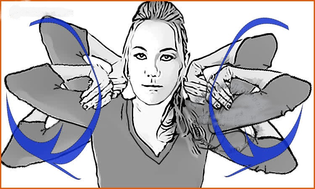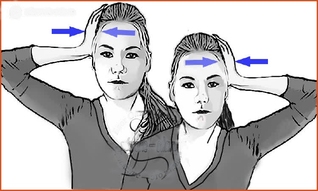There was a time when the disease was considered "age related", but more and more recently the disease was diagnosed with "necrotic bone disease" until the age of 35. This is due to a change in lifestyle - more and more people are engaged in sedentary and sedentary work. And most importantly is the physical activity, the endurance is reduced and as a result, blood circulation is also impaired, this has a major impact on the nutrition and recovery of the spinal disc.
An interesting fact: statistically, more than 80% of the population after 30 years of age have changes in the spine, no matter how small or much.
Reason
Osteochondrosis is the common name for the aging of the spine. This process is directly related to changes in the structure of the vertebra and the disc. Under the influence of internal and external factors, the disc becomes thinner. Appearance - convex convex, herniation, instability of the vertebra, changes to bone tissue, the appearance of bone cells (spikes, growth). And all of these phenomena are complications of osteonecrosis. This process is chronic and without complex therapy it will make it harder to live a more normal life even more.
You are probably already familiar with the factors that trigger dystrophic change, but we note again:
- Hypotension - it contributes to disruption of blood circulation in the neck, weakens the corset muscle.
- Curvature of the spine (hunchback, scoliosis, scoliosis curvature, scoliosis).
- Stay long in a stationary position and vice versa - increase the load and lift the weights.
- Injured.
- Overweight, pregnancy.
- Hereditary, metabolic disorder.
Humans are the only creatures on the planet with spinal problems in the ancient spine. This is due to our ability to walk completely, as well as muscle weakness and great ability to move the neck.
Has an important role in the formation of bone necrosis of the cervix with a genetic predisposition. Moreover, it is not necessary that a relative has osteonecrosis. The risk zone includes people with a family history of degenerative and dystrophic diseases of the skeletal system (arthritis, spondylitis, herniation, etc. ).
Stockis an important link. Many vessels and nerves pass through it to the brain. Problems in this part of the body will certainly affect the blood circulation to the brain and the work of the upper part - the shoulder, the arm. Degradation develops gradually, with an increase.
Developmental stages of cervical bone necrosis
In the early stages, there is local pain syndrome, accompanied by strong muscle tension, increasing inherent discomfort, limiting movement.
Pain is represented in two forms:
- Cervicago - "low back pain", sharp pain when moving.
- Cervical pain - tension, pain, constant muscle tension. It can take more than two weeks, even with the right treatment.
In the second stage, "lens" syndrome is added - compression of the nerve due to the thinning of the ligament and disc. Pain occurs when sneezing, coughing. If the person lies on his back and moves his head passively, painful sensations appear.
Numbness in the hands from the neck to the fingertips is a characteristic, especially after sleeping. This symptom quickly disappears after either active movements or placing your hands behind your head. If the numbness or pain persists, complications (bulging eyes, hernia) may develop.
Also, there may be a feeling of "freezing" the shoulder with the appearance of "shoulder-hand" syndrome - when arthritis of the shoulder and hand begins due to a circulatory disorder in bone necrosis.
Main symptoms
The main symptoms of necrosis of the cervix include:
- Headache and dizziness.
- Local pain, as well as possible irradiation to the shoulder, occipital or scapula (especially the next area of the pelvic region).
- Numbness and weakness in the arm.
- The tumor was in my throat.
- Hypertension of the arteries (persistent high blood pressure).
- Reduced hearing and vision, tinnitus (development of spinal artery syndrome).
Interesting thing: the changes in the disease affect the important vessels in the neck that supply the brain with blood. In patients with chondrosis, there may be "Sistine Chapel" syndrome - fainting after a strong blow to the head.
Angina and their localization are often disguised as a serious illness - angina pectoris.
Diagnosis and treatment
It is very important to treat the symptoms of cervical spondylolisthesis early in the degenerative process. To do this, you need to quickly seek the help of a psychiatrist or a chiropractor. But reality shows that they seek help, there have been complications - bulging eyes, hernias, instability of the vertebral bodies.
Patients should be examined carefully - echocardiography, cerebral and neck ultrasound, electrocardiogram, urine collection and blood tests. X-rays are required, and on some screenings and when placed with the mouth open (to see the vertebrae covering the teeth).
Unfortunately, doctors under the diagnosis of osteonecrosis correct many diseases, because they do not have time, experience, or desire to determine the cause of this or that symptom. A treatment is prescribed to provide temporary relief, but the real cause remains undetected, over time, things return again or not bring any remission at all. It is this situation that makes people self-medicate.
Treatment of necrosis of the cervical spine
Therapy should be as complete as possible.
- Physiotherapy.
- Drug treatment.
- Massage.
- Physiotherapy.
- Prolonged.
- Elongate the cervical spine according to Shishonin's method.
- Get out of habit.
Physiotherapy
The effectiveness of cervical degenerative treatment with physiotherapy and bath therapy has been scientifically proven.
- They relieve pain syndrome.
- Eliminates inflammation.
- Increases effectiveness of drug treatment and other treatments for cervical bone necrosis.
The therapeutic effect of physiotherapy in the form of low frequency pulsed electromagnetic therapy combined with radon baths, sometimes with iodine-bromine baths, is enhanced.
Drug treatment
In case of complications of necrosis of the cervical spine, herniation or large spheroid, a pinched nerve root inflammation. Therefore, to reduce inflammatory symptoms and stop pain, you need to apply intramuscular course of vitamins - B1, B6, B12. Also, with a decrease in blood circulation, blood viscosity increases, disrupting the brain's oxygen supply. It is necessary to use anti-platelet aggregation drugs.
Drug treatment.
- Eliminates pain and inflammation.
- Increases metabolic rate in tissues that have been impaired due to an impaired blood supply.
- Strengthens blood, improves blood circulation.
Massage
Neck massage is essential in a cervical necrosis program.
- Reduces muscle tension, thereby releasing constricted proximal arteries.
- Improves blood circulation and tissue nutrition, has a positive effect on the heart and brain.
- Relieves myalgia.
Unfortunately, good massage is not done for free and many people refuse this procedure because of the high price. But in the medical complex, massage of the cervical spine must be included for the sake of the case. Even they advise that it is not necessary like physical therapy exercises.
Physical therapy exercises
Treatment of bone tumors with cervical spine physiotherapy is the main method, and without this it cannot be recovered. There is no pill that can cure osteonecrosis without exercise therapy. Adjust the fact that you will have to exercise every day for a year to forget the symptoms of the disease forever.
Important: Exercise therapy is a 70% win against bone necrosis. Even when the pains go away, the disease is not gone anywhere. You cannot relax.
Goals and purposes of exercise therapy.
- Strengthens the deep neck and corset muscles of the shoulder so that the muscles that hold the head are in the correct position, do not strain the disc, and do not form protrusions that press on nerves. To increase the disc space, thereby eliminating the compression of the nerve roots.
- Return painless movement while developing flexibility and mobility.
- Exercise speeds up and increases blood circulation, thereby improving the nutrition of the disc and surrounding muscles.
Important: train yourself to do the exercises 3 times a day for the first 4 weeks, then once a day for a year.
Ancient exercises
Before doing any of these exercises, you need to warm up your muscles.
Starting
We heat up the chest muscles and the cervical spine. Slow circular motion with the shoulder - back and forth. Each muscle should be working as much as possible.

Round shoulder motion - lift as much as you can, move back, lower then forward. When pulling back - bring your shoulder blades together. And turn the same circles with each shoulder.
Add the arms - and repeat with the arm bent at the elbow. One by one, we will bring the shoulder blades together again while retracting our arms. And then we'll also move our shoulders forward as much as possible.
This ends the boot. Let's start with some basic neck exercises.
Training techniques
All movements should be done slowly, so as not to harm yourself and avoid pinching nerves.
Assuming the correct posture. The shoulders are low, slightly back, the chin parallel to the floor. Static exercises are designed to train the deep muscles of the neck. Each movement holds resistance for 5-8 seconds. Relax for two seconds and repeat again. Like that 5 times.
- We press our palm against the temple and press it to try to bow our head, we resist with our head, thus preventing our hand from tilting our head to the side. Do the same on the other side.
- Put your hand in the lock, rest your chin and press on the resistant end.
- We fight with our forehead.
- From the back of the head
- Instead, the head rested on one side of the cheekbones

As well as strengthening the neck muscles, you need to strengthen the shoulders at the same time. Some exercises with an expander must be included in the treatment complex 2-3 times a week.
Additional Downloads
Exercising in the form of running, brisk walking, swimming, aerobics will improve the whole circulation of the body. Especially due to the poor blood supply, the brain suffers, requiring oxygen for neck spine problems. Exercise lasts at least 20-30 minutes, up to 2 times a week.
Traction force drying the cervical spine
The drying method is horizontal and vertical. This method is called traction - a highly effective treatment for osteoporosis of the spine. Young people can easily recover completely, using only one traction during treatment. Since disk recovery at a young age much faster. Of course, age inhibits cartilage tissue repair and regeneration, but traction remains an important point in the complex treatment of cervical necrosis.
Elongation problem
- Increases the lumen between vertebrae.
- Eliminates the pain of pinching nerve roots.
This procedure has contraindications, so it should not be done without consulting a doctor. Previously, this method was only practiced in hospitals, nursing homes, and rehabilitation centers.

Skin stretching technique is available at home using the treatment necklace. Session lasts 15 minutes per day.
We have analyzed the entire treatment program for the cervical spine, it is still to talk about the usual way of life, should also change in perfect order.
Important: all methods above should be discussed with your doctor.
Getting out of habit
We understand that indolence and premature bone necrosis is a reason. If you don't get past them, then you don't need this article. Take the pain reliever and continue with the same activities. Though you can try to fix some bad habits.
- Sleep on orthopedic pillows and mattresses.
- Do not lie on your pillow for many hours, keep your head high while reading, playing on the phone. At this time, the cervical vertebrae will press on the blood vessels, disrupting blood circulation.
- Fixed posture of computer when time is not controlled. Set an alarm clock every hour to warm up your stiff neck muscles.
- Move more - play sports, exercise outdoors, walk 10, 000 steps a day.
Summary
The coursework - injection, massage and physical therapy is done every 6 months. During this period, physiotherapy exercises increase up to 3 times / day.
In other months every day:
- Exercise therapy - 1 time per day.
- Prolonged.
Repeat the process every 5 months. And this rate is at least a year. The positive results are noticeable within a month.
The above technique is not an algorithm for all cases of cervical osteonecrosis. All points should be discussed with the doctor. But if the doctor prescribes a method, such as physical therapy or massage, the effect is only temporary. The treatment takes long, so it's better to make adjustments right away for a successful recovery. Believe me, you won't get back to your old way of life by starting to exercise and feeling relieved.
How to treat cervical bone necrosis
Several classes of drugs are prescribed for basic drug treatment.
- Analgesic drugs are prescribed in the form of tablets, or for particularly severe pain, blockade of novocaine.
- Nonsteroidal anti-inflammatory drugs - Nurofen, Diclofenac.
- Irritating ointment - finalgon, bell peppers.
- Preparations for neck muscle relaxation - muscle relaxants.
- An intramuscular injection of vitamin B
Electricity support, massage, and warm compresses (cans, mustard plaster) are indicated in the main pain syndrome relief phase. During the period of exacerbations, pain is always present, to alleviate them, as well as muscle tension, the exercise therapy presented above is performed, a layer of pepper plaster is applied.
Important: any head rotation is prohibited in the case of vertebral artery syndrome, when the blood vessels in the neck are compressed due to bone necrosis.
At home, you can take a relaxing bath with colored water, apply compresses and rubs (eg propolis, aloe vera). Russian baths deal well with muscle tension. Traditional wet saunas with brooms help relax, relieve pain and cheer up.
In severe cases, it must be thanks to the intervention of the surgery, when the danger can be complicated by compression leading to disability. Specifically - complete compression of blood vessels or nerves, significant growth of bone-forming cells or the appearance of cranial convex. Surgery is performed according to all the rules of neurosurgery - under a microscope and with minimal incisions.







































